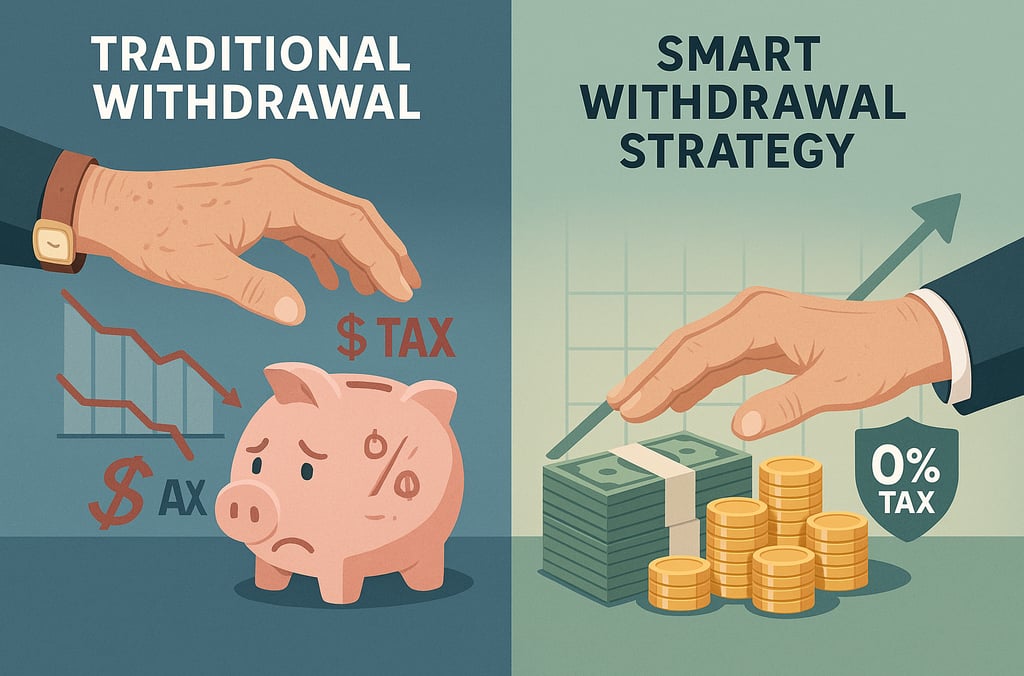The Retirement Tax Time Bomb: Why 401(k)s, IRAs, and “Safe” Accounts Could Cost You More Than You Think
Many people plan diligently for retirement, saving faithfully over decades. But what happens when it's time to actually use that money? The reality is, your withdrawal strategy can be far more critical than your growth rate. Without a clear and smart approach to taking income, you could be leaving hundreds of thousands on the table.
rakesh shah
6/10/20252 min read


Most people focus on how to grow their retirement savings — but overlook how they’ll use that money without losing a big chunk to taxes.
Imagine two friends, both saved $1,000,000 over 30 years for retirement.
One used a traditional savings or tax-deferred account like a 401(k) or IRA.
The other used a smarter strategy that offered tax advantages, market protection, and built-in legacy benefits.
They both want to retire and pull $50,000 per year.
Fifteen years into retirement, the friend using the traditional plan has nearly depleted their savings — taxed on every dollar they withdraw, with no growth on what they’ve already taken out.
The other friend still has hundreds of thousands growing — and is on track to leave a $400,000+ legacy for their family.
Same savings. Same withdrawal amount. Vastly different outcomes.
This isn’t luck — it’s strategy.
⚠️ Here’s Why Many “Safe” Choices Can Become Hidden Traps in Retirement
Too many people unknowingly choose options that feel safe — but leave them exposed when it matters most.
You Stop Compounding Once You Withdraw
Every dollar you pull from a traditional account is a dollar that stops working for you. Your balance shrinks — and so does your growth.Interest is Taxed Yearly, Eroding Real Returns
For savings accounts and CDs, growth is taxed every year, making it hard to even stay ahead of inflation.Sequence of Returns Risk Can Shrink Your Nest Egg
If the market drops early in your retirement, you may be forced to withdraw from a falling portfolio — accelerating depletion.Heirs Can Lose a Big Chunk to Taxes
Inherited 401(k)s or IRAs must be emptied within 10 years — and your heirs could lose 35–45% of it to taxes if they’re in high income brackets.
✅ Smart Strategies Solve This
The best solution isn’t just about saving more — it’s about withdrawing smarter.
A truly strategic retirement plan can help you:
Access Tax-Free Income
Withdraw money without triggering income tax, helping you keep more of every dollar.Continue Compounding While Withdrawing
Use strategies that allow your full account value to grow, even while accessing it through tax-free loans or structured income.Avoid Required Minimum Distributions (RMDs)
You won’t be forced to take income at a specific age — giving you control over when and how you access your money.Create a Built-In Legacy
Tax-efficient strategies often include a death benefit that bypasses probate and the IRS — passing more to your loved ones, tax-free.Gain Market Protection
Your account can be protected with a 0% floor, meaning you don’t lose money during down years — something most 401(k)s can’t guarantee.Safeguard Social Security and Medicare
Withdrawals from tax-deferred accounts count as income, which could raise your Medicare premiums or trigger Social Security taxes.
Smart withdrawals don’t count as income — so you avoid those traps entirely.Add Living Benefits as a Bonus
Some strategies also come with options for long-term care or critical illness coverage — benefits traditional retirement plans don’t provide.
🧠 Final Thought
The best time to plan your retirement exit strategy is before you retire — not after.
Whether you’re 25 or 55, it’s not just about what you save. It’s about how you structure your income.
These smarter strategies offer more than just tax savings — they give you control, legacy, and peace of mind.
💡 Make Your Money Work Smarter, Not Harder
Want to see how your current retirement plan stacks up against these strategies? I'll walk you through the numbers, show you the potential differences.
